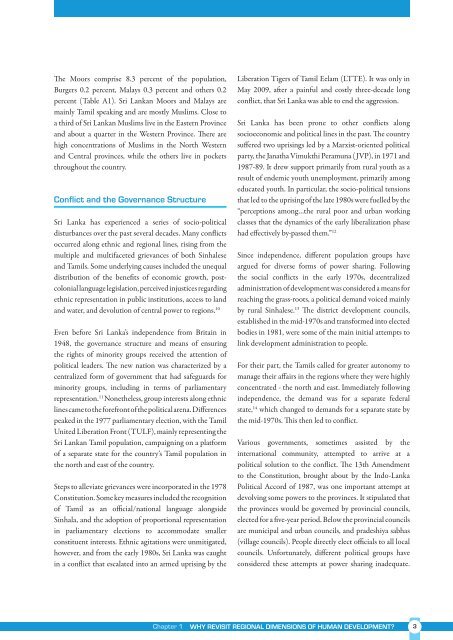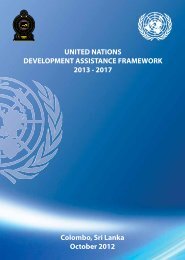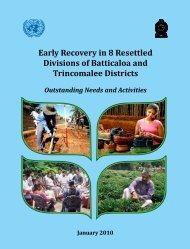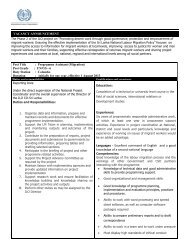Sri Lanka Human Development Report 2012.pdf
Sri Lanka Human Development Report 2012.pdf
Sri Lanka Human Development Report 2012.pdf
Create successful ePaper yourself
Turn your PDF publications into a flip-book with our unique Google optimized e-Paper software.
The Moors comprise 8.3 percent of the population,<br />
Burgers 0.2 percent, Malays 0.3 percent and others 0.2<br />
percent (Table A1). <strong>Sri</strong> <strong>Lanka</strong>n Moors and Malays are<br />
mainly Tamil speaking and are mostly Muslims. Close to<br />
a third of <strong>Sri</strong> <strong>Lanka</strong>n Muslims live in the Eastern Province<br />
and about a quarter in the Western Province. There are<br />
high concentrations of Muslims in the North Western<br />
and Central provinces, while the others live in pockets<br />
throughout the country.<br />
Conflict and the Governance Structure<br />
<strong>Sri</strong> <strong>Lanka</strong> has experienced a series of socio-political<br />
disturbances over the past several decades. Many conflicts<br />
occurred along ethnic and regional lines, rising from the<br />
multiple and multifaceted grievances of both Sinhalese<br />
and Tamils. Some underlying causes included the unequal<br />
distribution of the benefits of economic growth, postcolonial<br />
language legislation, perceived injustices regarding<br />
ethnic representation in public institutions, access to land<br />
and water, and devolution of central power to regions. 10<br />
Even before <strong>Sri</strong> <strong>Lanka</strong>’s independence from Britain in<br />
1948, the governance structure and means of ensuring<br />
the rights of minority groups received the attention of<br />
political leaders. The new nation was characterized by a<br />
centralized form of government that had safeguards for<br />
minority groups, including in terms of parliamentary<br />
representation. 11 Nonetheless, group interests along ethnic<br />
lines came to the forefront of the political arena. Differences<br />
peaked in the 1977 parliamentary election, with the Tamil<br />
United Liberation Front (TULF), mainly representing the<br />
<strong>Sri</strong> <strong>Lanka</strong>n Tamil population, campaigning on a platform<br />
of a separate state for the country’s Tamil population in<br />
the north and east of the country.<br />
Steps to alleviate grievances were incorporated in the 1978<br />
Constitution. Some key measures included the recognition<br />
of Tamil as an official/national language alongside<br />
Sinhala, and the adoption of proportional representation<br />
in parliamentary elections to accommodate smaller<br />
constituent interests. Ethnic agitations were unmitigated,<br />
however, and from the early 1980s, <strong>Sri</strong> <strong>Lanka</strong> was caught<br />
in a conflict that escalated into an armed uprising by the<br />
Liberation Tigers of Tamil Eelam (LTTE). It was only in<br />
May 2009, after a painful and costly three-decade long<br />
conflict, that <strong>Sri</strong> <strong>Lanka</strong> was able to end the aggression.<br />
<strong>Sri</strong> <strong>Lanka</strong> has been prone to other conflicts along<br />
socioeconomic and political lines in the past. The country<br />
suffered two uprisings led by a Marxist-oriented political<br />
party, the Janatha Vimukthi Peramuna ( JVP), in 1971 and<br />
1987-89. It drew support primarily from rural youth as a<br />
result of endemic youth unemployment, primarily among<br />
educated youth. In particular, the socio-political tensions<br />
that led to the uprising of the late 1980s were fuelled by the<br />
“perceptions among…the rural poor and urban working<br />
classes that the dynamics of the early liberalization phase<br />
had effectively by-passed them.” 12<br />
Since independence, different population groups have<br />
argued for diverse forms of power sharing. Following<br />
the social conflicts in the early 1970s, decentralized<br />
administration of development was considered a means for<br />
reaching the grass-roots, a political demand voiced mainly<br />
by rural Sinhalese. 13 The district development councils,<br />
established in the mid-1970s and transformed into elected<br />
bodies in 1981, were some of the main initial attempts to<br />
link development administration to people.<br />
For their part, the Tamils called for greater autonomy to<br />
manage their affairs in the regions where they were highly<br />
concentrated - the north and east. Immediately following<br />
independence, the demand was for a separate federal<br />
state, 14 which changed to demands for a separate state by<br />
the mid-1970s. This then led to conflict.<br />
Various governments, sometimes assisted by the<br />
international community, attempted to arrive at a<br />
political solution to the conflict. The 13th Amendment<br />
to the Constitution, brought about by the Indo-<strong>Lanka</strong><br />
Political Accord of 1987, was one important attempt at<br />
devolving some powers to the provinces. It stipulated that<br />
the provinces would be governed by provincial councils,<br />
elected for a five-year period. Below the provincial councils<br />
are municipal and urban councils, and pradeshiya sabhas<br />
(village councils). People directly elect officials to all local<br />
councils. Unfortunately, different political groups have<br />
considered these attempts at power sharing inadequate.<br />
Chapter 1 WHY REVISIT REGIONAL DIMENSIONS OF HUMAN DEVELOPMENT 3






